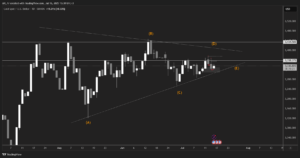Gold prices rose during these trading moments today, Wednesday, moving in limited ranges with the rise of the dollar, as investors await more clues about the direction of the US Federal Reserve’s monetary policy.
The dollar index rose during today’s trading against its rivals, making gold more expensive for holders of other currencies. Gold prices had risen by more than 5% so far this year and hit a record high last week, supported by increased bets on monetary easing from the Federal Reserve and continued demand for safe havens and central bank purchases amid geopolitical tensions.
It is difficult to build a strong bearish case for gold prices given the current geopolitical backdrop and potential monetary easing.” The Federal Reserve left the federal funds rate unchanged between 5.25% and 5.5% last week and maintained its forecast for three cuts by the end of 2024.
Investors are now looking ahead to the US Personal Consumption Expenditures Price Index data due on Friday to gauge when the Fed might start cutting rates. Traders expect a 72% chance that the Fed will start cutting rates in June, according to the US Interest Rate Watch Tool available on Investing Saudi Arabia. Lower interest rates reduce the opportunity cost of holding bullion. SPDR Gold Trust, the world’s largest gold-backed ETF, reported that its holdings fell by 0.62% to 830.15 tones on Tuesday.
Gold and the dollar now
Gold futures are now up 0.15% to $2181 an ounce. Spot gold is now up 0.13% to $2182 an ounce. On the other hand, the dollar index is up about 0.11% to 104.110 points.
Other metals
Silver was flat in spot trading at $24.44 an ounce, platinum gained 0.2% to $905.05, and palladium fell 0.5% to $988.81.
Japan issues warning after yen falls to 34-year low
Yen hits lowest level since 1990 against US dollar. The Japanese yen fell in the European market on Wednesday against a basket of global currencies, deepening its losses for the second day in a row against the US dollar, hitting a 34-year low, on the verge of trading below the 152 yen per dollar barrier, following less hawkish comments from a Bank of Japan member.
The fall of the local currency to its lowest level in three decades prompted Japanese authorities to issue the strongest warning yet about possible intervention in the foreign exchange market, with the finance minister saying authorities could take “decisive steps,” a phrase previously used before actual intervention to protect the currency from excessive weakness.
Why is the yen falling after the Bank of Japan raised interest rates?
The Japanese yen has fallen by about 1.5% since the Bank of Japan raised interest rates last week, as traders continue to focus on the stark interest rate differentials that remain between Japan and the rest of the advanced economies, particularly the United States. Despite the Bank of Japan raising interest rates for the first time since 2007, markets now believe that further increases may take some time.
Japanese Finance Minister Shunichi Suzuki said on Wednesday that Japanese authorities are watching foreign exchange market movements very closely and will take “decisive steps” to protect the local currency.
The phrase “decisive steps” has been used in the past before actual intervention in the foreign exchange market, and Shunichi Suzuki previously used the phrase “decisive steps” in the fall of 2022 when Japan last intervened in the market to stop the weakening of its currency.
Oil prices fall for a second day as US crude stocks rise
Oil prices fell for a second day in a row on Wednesday after a report of higher crude stocks in the United States, the world’s largest oil consumer, and indications that major producers are unlikely to change production policy at a technical meeting next week.
US West Texas Intermediate crude futures for May delivery fell 64 cents, or 0.8%, to $80.98.
Prices fell this week after rising to their highest since October last week and remained about three percent above their closing average in the first week of March.
US crude oil stocks rose by 9.3 million barrels in the week ended March 22, according to market sources citing American Petroleum Institute figures on Tuesday. Distillate stocks also rose by 531,000 barrels.
Three sources from the OPEC+ alliance told Reuters ahead of next week’s meeting that the group, which includes the Organization of the Petroleum Exporting Countries (OPEC) and allies led by Russia, is unlikely to make any changes to oil production policy before a full ministerial meeting in June.
The group will hold an online meeting of the Joint Ministerial Monitoring Committee on April 3 to review market implementation and members’ compliance with production cuts.
For further insights, check OneRoyal’s Facebook, Instagram, and Twitter pages and expand your understanding of financial markets with global perspectives. Staying informed is crucial in the ever-evolving world of finance.
Disclaimer: This article is not investment advice or an investment recommendation and should not be considered as such. The information above is not an invitation to trade and it does not guarantee or predict future performance. The investor is solely responsible for the risk of their decisions. The analysis and commentary presented do not include any consideration of your personal investment objectives, financial circumstances, or needs.





